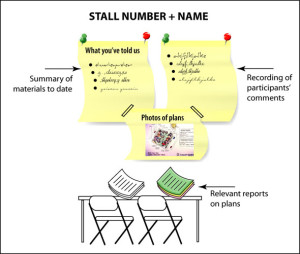The book consists of 13 chapters, illustrated by tailor-made illustrations and photographs from professional practice:
Chapter 1 Introduction: introduces the book and describes the book’s origin, aims and target readership.
Chapter 2 Why Manuals Are Important: explains the importance of manuals to address the prevalent ineffectiveness and inadequacy in community engagement processes. It includes lessons from past SpeakOuts.
Chapter 3 Introducing the SpeakOut: introduces the SpeakOut model by examining the need for this approach and offering a clear, step-by-step explanation of its features.
Chapter 4 Five Successful SpeakOut Stories: presents recent SpeakOut case studies in three countries, focusing largely on methods in very different contexts.
The five cases are:
1 Bonnyrigg, Sydney, 2005
2 Talk Any Kine, Honolulu, 2006
3 Thunder Bay, Ontario, Canada, 2007
4 Townsville, Queensland, 2007
5 False Creek North, Vancouver, 2007.
Chapter 5 Designing a SpeakOut: details the essential components for preparing, designing and managing a SpeakOut, including the organizing structure of the `Outer Circuit’ and `Inner Circuit’.
Chapter 6 Interactive Exercises at SpeakOuts: offers a rich menu of innovative interactive activities piloted and refined at SpeakOuts over two decades.
Chapter 7 SpeakOuts for Children: introduces SpeakOuts for children and describes an innovative SpeakOut conducted in 2007 in Queensland.
Chapter 8 Vote with Your Hands: describes an exercise called Vote with Your Hands, a common and popular feature of SpeakOuts.
Chapter 9 Designing and Managing Community Workshops: explores requirements for a community workshop, building on Chapter 6.
Chapter 10 Staffing, Facilitation and Recording: outlines essential requirements to ensure effective staffing, facilitation and recording.
Chapter 11 Analysis of Materials Generated by a SpeakOut or a Workshop: the amount of work put into a SpeakOut by committed staff and participants does not automatically morph into a completed report. This important chapter briefly summarizes the steps for analysing materials to create a reliable record.
Chapter 12 Other Considerations: addresses other requirements for achieving a successful SpeakOut, including communication (technology, signs and badges), audio and visual recording, drawcards, models and aerial photographs, child and infant care, food, entertainment, interpreters, involvement of senior people, `greening’ and insurance.
Chapter 13 Evaluation: briefly summarizes some useful approaches for assessing and evaluating SpeakOut exercises.
The book concludes with Notes for all chapters and a comprehensive Bibliography.
It also contains a detailed Glossary and two Appendices: a checklist for SpeakOuts and templates for some typical interactive activities (the Footscray Stall Prompts).
